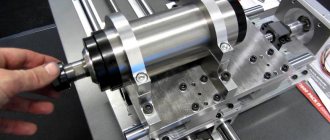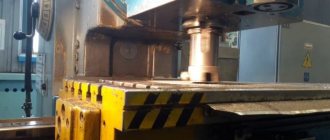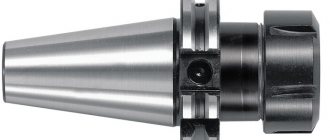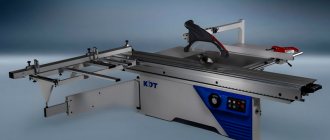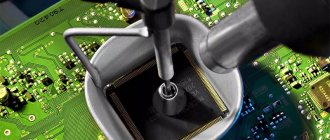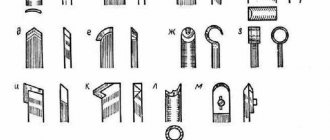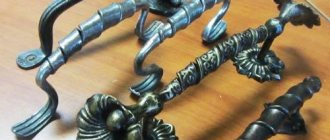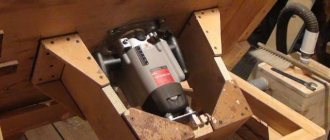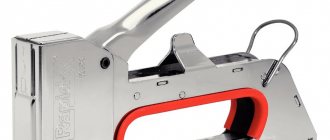The spindle is the motor that spins the cutter on a CNC router. Its main task is to transmit torque to the cutter. Used for milling, drilling metal and wooden surfaces, processing parts, etc.
There can be many key factors in choosing the right spindle for your CNC router. First of all, these are engine power, rotation speed and torque. Secondly, many experts note the quality of the clamping of cutters and other types of cutting tools. In this article we will look at the classification of spindles and find out details about the purpose of each type.
What is a spindle?
At the mechanical engineering department of any polytechnic university they will say that a spindle is a shaft that is used as an intermediate device between the machine and the material being processed. It uses a collet to secure the cutting tool, and the length of the shaft can be adjusted. Spindles are divided into two main types:
Industrial . Used for lateral loading. It has an increased margin of safety and power, you can additionally connect a lubrication system and a cooling system, it is connected and controlled from a CNC controller.
Amateur . A regular drill or low-power milling machine. It is used in everyday life and is used to distribute the load vertically relative to the body of the device. As a rule, such spindles have a simple configuration, are controlled manually, and are not connected to a CNC controller.
A low-power amateur spindle cannot be used for industrial machines. Their configuration easily copes with tension and compression. However, they are not designed for lateral loads. In addition, increasing the spindle speed leads to rapid heating and a decrease in power.
Principle of operation
The basis of the operation of each machine is the use of cutting tools. Thanks to the spindle design, the cutter can be fixed and rotated. The spindle, depending on the technological features of processing, can operate in high-speed or power mode. It all depends on the thickness of the cut of the material during a single contact with the cutting tool. This processing method most often does not require special precision. When operating in this mode, the spindles require high torque and sufficient power. Such devices are characterized by increased rigidity and strength.
The operating principle of high-speed spindles is based on the need to cut small layers of processed materials. To maintain the performance of the device, an increased speed mode of operation is required. Such spindles are used for finishing materials, and therefore do not require high power and increased cutting force.
The spindle can be powered by a special electric motor installed next to it. The rotational speed is transmitted to such devices through a gear or belt drive. Such schemes are typical for devices of the power principle of operation.
Some spindles are essentially an electric motor shaft, and all intermediate gears are missing. The balancing requirements for components of such devices are often very high. Almost always, such spindles are produced as independent devices. This design feature allows you to install it in any convenient way.
Speed and power spindles also differ in the type of attachment of cutting tools. For high-power devices, special conical-shaped adapter bushings are provided. First, the cutter shank is fixed in this sleeve, and then mounted in the spindle hole. In high-speed devices, the cutting tool is almost always installed in a collet, which is clamped with a nut.
Milling machine spindle power
If you are faced with the task of choosing a spindle for a CNC milling machine, first of all you should pay attention to the power parameters of the device. All experts and at all times recommended not to skimp on this parameter. The more power, the more serviceable the device will be.
At the same time, if you purchase a spindle to work with a specific type of material, then you should pay attention to how much power the device will need for this. Plywood, particleboard and fibreboard will require a spindle with a power of 1500-3000 W. Natural wood and soft metal alloys will require up to 5000-6000 W.
Depending on the type of work performed, there are the following requirements for spindle power:
- 500 to 600 W is usually required for general drilling and engraving,
- from 900 to 1500 W will be needed for processing solid wood,
- more than 1500 W will be needed for CNC machines designed for intensive work on an industrial scale.
About the advantages of spindles
A homemade design involves the use of a machine with an inclined spindle.
List of advantages:
- Equipping the machine with inexpensive clamping devices.
- Manufacturing diagrams are easy to find on Internet resources.
- Simplicity of the design solution.
- Additional equipment with any elements of the corresponding parameters.
If you are not sure that a self-made metal spindle for CNC or wood will not work effectively, then to avoid the risk, you can purchase a factory-made product.
Spindle selection: rotation speed
The selection of a spindle based on the motor power characteristics should also be made based on the type of material that is planned to be processed. Each manufacturer publishes a range of speeds at which the router can be used to carve metal or wood. The following are usually considered average values:
- For shallow wood engraving, low-power spindles capable of performing up to 25 - 35,000 revolutions per minute are recommended. When choosing a spindle, it is recommended to choose a model that demonstrates the maximum in a given range. That is, if you only need 24-30 thousand revolutions, but there is an opportunity to use 35, it is better to opt for the latter option.
- For soft metal alloys (aluminum) you will need 13 - 8,000 rpm.
Why does wood require more turns than metal? The answer is actually obvious. For each type of material, cutters of different sizes are used. For metal, for example, solid plates made of hard alloys with a diameter of no more than 16 mm are used. The second aspect is the type of milling. High-speed is used for wood processing . It implies high torque, but low feed. For metal, power milling is used, which requires fewer revolutions, but with a more intense feed.
What is a spindle for a lathe?
Review of the 675 milling machine: characteristics, design
The spindle for a lathe is a shaft with a hole in the middle. Blanks for future parts are inserted into it, into the hole. It is made of high-strength steel, since it is constantly under heavy load. Now a little more detail.
Drawing and design of the device
The design of the spindle depends on a large list of factors. For example, on what work will need to be completed, or on the speed at which the work will occur. You can also add types of machine to this list, since different types require different spindles.
Requirements for the spindle unit
In the past, the main support for this unit was the bearings on which the spindle rotates. The deviation on them reached about one micrometer. Now everything has changed: now the requirements for modern spindles have increased, and they are manufactured using either magnetic or air supports.
This allows you to achieve much better results than when using bearings: now deviations from the norm are only about two-tenths of a micrometer, which allows you to work with even the most complex parts without fear of producing defects.
However, two tenths of a micrometer is not a limit. Using a flywheel that accelerates the spindle, it is possible to reduce the error to three hundredths of a micrometer, which is much less than the previous result. True, such work must be performed after the flywheel is turned off. That is, work is performed due to inertia, with the help of which the spindle continues to move.
Here is a list of requirements that spindle units must meet:
- Accuracy. This requirement is checked based on the machine for which the spindle is needed and the application.
- Processing speed. Spindle units always rotate at different speeds (this depends on the type). To put it bluntly: the faster, the better. The speed determines the level of quality of the completed part.
- Rigidity. It's not the same with speed. That is, the lower, the better. It is calculated using the ratio of the spindle deflection and the level of radial runout. Having calculated the resulting number for two spindles, we can say which one is better.
- "Lifetime". This indicator means how long the spindle can last when performing the intended work. It depends on which bearing is used during operation. Naturally, the worse it is, the faster the spindle assembly will break.
- Vibration resistance. Naturally, during operation the machine vibrates a lot, which can lead to defects if the spindle does not meet this requirement. If the spindle assembly does not tolerate vibration well, then the level of accuracy during operation will be noticeably lower.
- Maximum heating level. This is one of the most important requirements. During operation, the spindle assembly gets very hot due to the friction force, and therefore sometimes it needs, so to speak, to “rest” from work. If it gets too hot, it may begin to change and break, so you need to choose the one that is most resistant to high temperatures.
- Maximum weight tolerated. Thanks to this requirement, it is possible to determine what weight the tools can be mounted on the spindle assembly. The size of the tool used also depends on this indicator.
Taking into account all these requirements for the spindle, you can choose the spindle unit that is best and most suitable for the job.
Purpose and principle of operation
The most important and, as a result, the main purpose of the spindle assembly is to attach a chuck to it, which in turn is intended for clamping the workpiece of the future part.
Reference! The workpiece is secured to the spindle using a special chuck, faceplate or collet clamp, which are attached to the end of the spindle.
Selecting a spindle manufacturer
On the international market, Chinese and Italian spindles are most widespread. In this regard, a reasonable question arose: which one is better? We are convinced that each manufacturer has its own advantages and disadvantages, and each product is beneficial in its own way.
Italian-made devices are superior in quality and assembly. They have built-in air cooling. They perform excellently at high speeds and exhibit neat carvings.
At the same time, Chinese spindles will cost much less, and are unlikely to yield in quality, since they are still manufactured in the same factories in China as Italian spindles. Thanks to the solid cylindrical body, which is closed with bearing units, it produces almost no vibration while maintaining a stable position on the machine. The power of such a spindle may seem less than that of its Italian counterparts. However, Chinese models are unpretentious to environmental conditions, do not deform from excessive heat and can be used in daily work.
Installation
The air cooling system is an ordinary built-in screw, which is driven by the rotation of the spindle shaft. To connect the liquid cooling system, you will need to attach the spindle to the filling tank using suitable tubing and fittings.
In addition to liquid cooling systems, special frequency converters are also used to install most spindles on the machine, through which the power supplied to the motor is regulated. The power range of each converter must match the power consumption of the spindle in order not to reduce the productivity of the device. Some experts recommend calculating the power of the converter with a margin so that the ability to supply energy to the motor exceeds the maximum power of the spindle. To connect, simply connect the contacts on the spindle to the corresponding connectors on the converter.
Why should you choose us?
Did you need to buy a CNC milling machine spindle? Our store's assortment includes items for all types of milling equipment. We will help you choose a spindle of suitable power to carry out work of all levels of complexity and help you understand the settings and installation of equipment.
Our advantages:
- A wide range of products,
- Knowledge of the matter. We don’t just sell me a product, we really understand the equipment and know how to use it.
- We will help you find a spindle for your machine,
- We provide discounts to regular customers,
- Service maintenance. The spindle always needs maintenance. We will provide it.
Call our store specialists to find out the details of the models presented in the catalog, as well as to find out the specifics of placing an order.
Features of spindle design for a CNC machine
Source: woodshopnews.com
The spindle design is designed to withstand high loads in the vertical and horizontal directions. To ensure high reliability, spindles are assembled in temperature-controlled rooms.
To ensure exceptional rotational accuracy, the device uses special high-speed bearings. The ends of the spindle are bored and ground to a cone (ISO, BT, SK, HSK, Morse, etc.). This solution ensures a tight fit of the milling mandrel and precise installation of the cutter. To fix the mandrel with the cutting tool, an external force is required, which is provided by a set of disc springs.
The main elements of a spindle are a fixed body, a rotator, a set of bearings, a coolant system, as well as pulleys, balancing rings and other auxiliary parts.
Types, types, categories of spindles
Collector spindles are used for engraving and jewelry processing of miniature items.
Most often these are high-speed devices with an ER8 collet with a power of about 0.8 kW. ER11 collets are more suitable for cutting and cutting soft materials. High-speed commutator spindles have proven themselves in professional and amateur use in CNC machines. Some devices are equipped with soft start systems that limit the incoming voltage. Liquid-cooled devices are often used in high-quality industrial units at enterprises in our country. The motor is effectively cooled with water or antifreeze. These spindles are equipped with high-speed iron bearings that do not require additional maintenance. These devices are controlled through frequency converters. The cutters are mounted in collets and secured with a nut. Devices from both European and Chinese manufacturers are available on the modern market.
Belt driven spindle
Belt-driven spindles interact with AC servo drives or asynchronous motors. This feature makes it possible to precisely regulate the rotation speed of the tool. Air spindles are cheap and reliable devices for computer-controlled machines. For the most part, these are Chinese-made devices with installed ceramic bearings that can withstand high speeds. Some spindles have the ability to automatically change cutting tools.
Technical characteristics and scope
There are a large number of spindles available in the market today. Cooling systems, technology for driving the rotor, the method of fixing the cutting tool and regulating the power supply to the motor may also differ. Therefore, it is best to classify all spindles available for sale according to the type of material they process. The capabilities of each device are determined by their technical characteristics.
Scope of application of the spindle: portal CNC machines
Spindles with a power of 0.8 kW are used for processing jewelry, for creating engravings, cutting plastic parts up to 5 mm thick, thin plywood, as well as for cutting and drilling printed circuit boards. Very thin engravers and miniature cutters are usually installed in such devices. High-speed spindles with power starting from 1.2 kW can be used with high-quality carbide cutters for processing metal products. To work with thin, durable cutters, spindles with a rotation speed of 30,000 rpm are always used.
Spindles with a power of 1.5 kW are used for processing souvenirs and creating shallow milling on brass and aluminum objects. They are also the entry-level tools for processing hardwood or acrylics up to 15mm thick. Power from 2.2 kW allows you to process hard wood and acrylics up to 30 mm thick. Devices from 3 kW can be used for durable materials. For example, they are often used in 3D hardwood or shape cutting applications. 4 kW spindles are used when cutting hard materials. Devices with a power of 4.5 kW and above allow you to work most efficiently with large cutters for thick workpieces of wood or metal.
| Power, kWt) | Rotation speed (rpm) | Processed materials | For water cooling (l./hour) | Pump |
| 0,8 | 8000-24000 | Thin plastic, plywood, engraving of metal products | 780-1500 | Pump DB-25A-220V |
| 1,5 | 8000-24000 | Brass, aluminum | 1500-3000 | Pump DB-50A-380V |
| 2,2 | 8000-24000 | Hardwood | 1500-3000 | Pump ZWP75 |
| 3 | 8000-24000 | High strength metal blanks | 2000-3000 | Pump ZWP150 |
| 4.5 and above | 8000-24000 | Solid wood and metal blanks | 2000-5000 | Pump DB-100-380V |
For example, consider the characteristics of products from the most popular manufacturers:
- High-speed Chinese air- and liquid-cooled spindles GTM, HNZ, HQ, TDK with a power range of 0.8-6 kW and a rotation speed of 8000-18000/24000 rpm are available on the domestic market. with collets ER11, ER16, ER20, ER
- Belt-driven spindles BT30 for machining ferrous/non-ferrous metal workpieces with a rotation speed of 6000 rpm. Some products are equipped with an automatic cutting tool replacement system;
- Mini-spindles with air cooling systems with a power of 300-1050 W and a rotation speed of up to 32,000 rpm. Among these products are products from Kress.
Main types of milling machines and their designations
Home » Articles » Professionally about metalworking » Milling machines
We recommend purchasing:
Installations for automatic welding of longitudinal seams of shells - in stock!
High performance, convenience, ease of operation and reliability in operation.
Welding screens and protective curtains are in stock!
Radiation protection when welding and cutting. Big choice. Delivery throughout Russia!
Milling machines have a very wide range of applications and are divided into two main groups: general-purpose and specialized machines. The first group includes cantilever and non-cantilever machines, longitudinal milling machines, continuous milling machines (rotary and drum). The second group includes copy-milling machines, gear hobbing machines, thread milling machines, key-milling machines, slot milling machines, etc. The standard sizes of machines are characterized by the area of the working (fastening) surface of the table or the dimensions of the workpiece being processed (for gear and thread machining). According to this characteristic, the machines have five gradations:
View photo in actual size
The classification of milling machines is given in table. 1.1, which lists nine types of machines of the sixth group (in addition, milling machines are also included in the fifth group of gear and thread-processing machines, which are not discussed in this book). Each machine has its own code, the first digit in which indicates the group of the machine, the second - its type (1 - cantilever vertical milling (Fig. 5.1, a), 2 - continuous action (Fig. 5.1, b), 4 - copying (Fig. 5.1, c) and engraving, 5 - vertical non-cantilever (Fig. 5.1, d) (with a cross table), b - longitudinal milling (Fig. 5.1, e), 7 - wide-universal (Fig. 5.1, f), 8 - cantilever, horizontal (Fig. 5.1, g), 9 - different). The third and, if necessary, fourth digits indicate the characteristic dimensions of the machine. In addition to numbers, the machine model designation may include a letter. If the letter appears between the first and second digits, this means that the design of the machine has been modified. For example, the universal console machine has been improved over the years and was designated 682, 6B82, 6N82, 6M82, 6R82 and 6T82.
If the letter appears at the end of the machine code, this may mean the following: 1) a structural modification of the main model (for example, 6Р82Г - horizontal milling machine, 6Р12Б - high-speed model, 6Р82Ш - wide-universal); 2) different designs of machines depending on the accuracy (N - normal accuracy, P - increased, B - high, A - especially high and C - especially precise machines, called master machines); 3) different designs taking into account the machine control system used.
Design and technical features
Knowing the structure of a milling machine, a person immediately understands what a spindle is and where it is located. For those who do not know the design and technical parameters, it is necessary to understand everything gradually.
The spindle is a hollow metal shaft that is the key component in a milling machine. This part is installed on a special carriage, with the help of which it moves in three planes - X, Y, Z. When the engine is turned on, the shaft directly transmits rotational force to the cutter (if we are talking about a machine that uses metal cutters). Due to the absence of additional elements when transmitting force from the engine, the torque is not distorted.
Spindle for a homemade machine. Spindle machine for wood.
Advantages and disadvantages of models
Spindles from European manufacturers are distinguished by their stable performance during the warranty period under normal operating conditions. The devices are simply assembled and disassembled if you have the necessary tools. The design of spindles from leading European manufacturers is always very well thought out and has almost no flaws. In many housings, the rear bearing assembly is robustly designed. Only high-quality materials are used for stator winding in such devices. Almost all manufacturers pay attention to the noise level of their products.
The disadvantages of such products include the fact that the plastic parts of the body are their weak points. In some applications, bearings can be overloaded and work to their limits. This circumstance increases the likelihood of damage to the spindle housing. The rotor shaft of many devices is made of mild steel, and the threads on them are often very sparse. This causes a reduction in service life. Air-cooled spindles may not have enough power from the built-in fans, so you have to buy additional devices. Some manufacturers forget to lubricate the spindle bearings.
